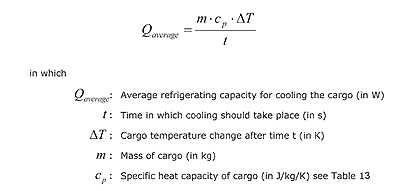A modern refrigeration unit has a refrigeration capacity of approximately 5 to 6 kW in low-temperature operation at -18°C. Depending on the container type being used (20' / 40'), 1.5 kW through 2.6 kW will be required in order to remove the heat that enters through the insulation. This leaves approximately 2.4 to 4.5 kW that can be used to cool the cargo.
The following applies:
 |
If the refrigeration capacity is known, the maximum cooling speed can be determined. If a refrigeration capacity of 4 kW is available for cooling (see above) then it would be possible to cool, for example, 10 tons of frozen meat by roughly 1.1°C per hour.
This maximum cooling speed is usually not achieved since the heat transferred from the goods to the air is less then the refrigeration capacity. This is particularly relevant for frozen cargo and cargo containing non-respiring goods (goods other than fruit and vegetables) where the goods are usually packed using the block stowage method and the air is only able to flow around the goods and not between the boxes. If the air is not able to transfer the refrigeration capacity to the cargo, this means that because the air is cooled rapidly because of the high capacity of the refrigeration unit but the cargo itself takes far longer to cool (see above).
The often repeated claim that goods in a refrigerated container cannot be cooled and that it is only possible to maintain the temperature in the container, is not valid as the information given above has shown. When transporting fruits, in particular bananas, the cargo is often cooled in the container. However, it is true that refrigerated containers are not suitable for providing high-quality freezing of products. It is possible to freeze products in a refrigerated container, but this process is relatively slow and leads to increased production of ice crystals which are simply not acceptable in a top-quality frozen product. For this reason, top-quality freezing results can only be achieved using specially designed equipment that freezes products very quickly.